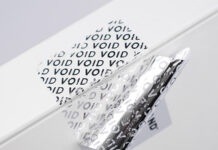The printing industry faces two main challenges: continuing cost pressure and a shortage of skilled workers. Heidelberg offers print shops solutions that can help with both these key issues because costs per printed sheet are fundamental for printers and state-of-the-art sheetfed offset technology by Heidelberg ensures competitiveness
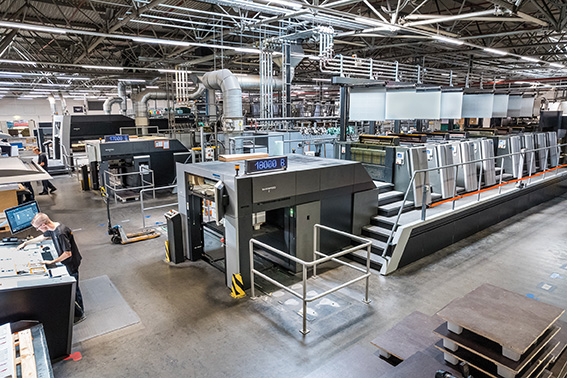
“Cutting-edge sheetfed offset technology by Heidelberg is becoming ever more productive compared to the previous models. In certain cases, it can even double a print shop’s output thanks to the combination of Push to Stop and Performance Services. By automating the printing process, we are also helping to compensate for difficult jobs to realize” says David Schmedding, the company’s Global Head of Sales & Marketing.
Efficiency and productivity, with a printing speed of 21,000 sheets per hour, the Speedmaster XL 106 makes it possible to increase net output in folding carton production by up to 10% compared to the standard configuration with an output of 18,000 sheets per hour.
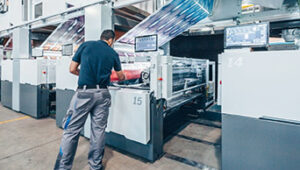 For in-mould label production on the Speedmaster XL 106, Heidelberg offers a performance package designed for the specific requirements of in-mould materials that enables up to 15% higher production speeds to be achieved. The new Boardmaster flexographic web printing system is all about efficiency. It achieves double the productivity of comparable systems in folding carton production and boasts an availability of up to 90% and a maximum printing speed of 600 meters per minute, which is equivalent to around 38,000 sheets per hour in format 6 (sheet width: 148 cm).
For in-mould label production on the Speedmaster XL 106, Heidelberg offers a performance package designed for the specific requirements of in-mould materials that enables up to 15% higher production speeds to be achieved. The new Boardmaster flexographic web printing system is all about efficiency. It achieves double the productivity of comparable systems in folding carton production and boasts an availability of up to 90% and a maximum printing speed of 600 meters per minute, which is equivalent to around 38,000 sheets per hour in format 6 (sheet width: 148 cm).
Automation to combat the skills shortage thanks to more and more automatized processes on Speedmaster presses that relieve the strain on operators. Prinect software integrates all processes – from incoming orders through to shipping – into an end-to-end workflow, while the established Push to Stop concept ensures highly automated operations that can also be linked to third-party workflows.
Besides boosting productivity, Plate to Unit can also alleviate the skills shortage at print shops. By almost fully automating the process of supplying and removing printing plates on the press, it ensures reliably high productivity and reduces the risk of plates being damaged.
Intelligent algorithms: the use of artificial intelligence (AI) makes life easier for printers by supporting the automatic configuration of complex production parameters. Initial functions include the process optimization solution Preset 2.0, the intelligent assistance systems Intellistart 3, Wash Assistant, Powder Assistant, and Color Assistant Pro, and the company’s Performance Advisor Technology (PAT) PAT, that acts as a kind of digital colleague. It visualizes and structures data, also offering practical suggestions and tips for improvements that boost productivity and save on resources.
Sustainability cuts costs: the energy efficiency of printing presses is improving all the time, for example with enhanced standby functions, ultra-efficient blowers such as those in AirStar Pro air supply cabinets, and a workflow that minimizes waste all lower costs. In this connection, special consulting teams visit customers and hold energy workshops to analyze where they can save on resources and cut costs.
Digital press setup via touch control, that can boost print shop performance in just a few clicks. The Speedmaster Operating System with intuitive operator guidance based on touch control (Heidelberg UX) ensures user-friendly control of the press. The Speedmaster Operating System is controlled via a 24-inch multi-touchscreen. Operators can call up settings with a click, while the scalable operation can be flexibly adapted based on the requirements profile (Smart Setup). What’s more, the system offers innovative gesture control and integrated help functions in 27 languages.
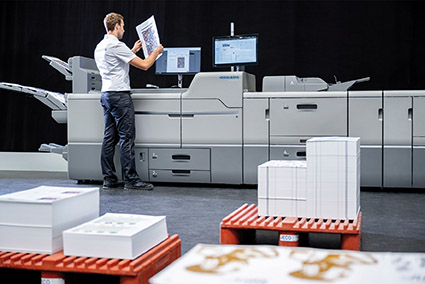
Two printing technologies in one, because Heidelberg seamlessly combines digital and sheetfed offset printing. The new digital printing systems Versafire LV and Versafire LP are equipped with an enhanced Prinect Digital Front End (DFE), thereby ensuring intuitive interaction of offset and digital printing technology. Offering comprehensive process and application expertise relating to both offset and digital printing makes Heidelberg unique in the industry.
Precision down to the last detail, because precision is everything and is evident from the accuracy in production of core components. Heidelberg foundry at the Amstetten site manufactures high-precision components for the company’s presses and also for industrial customers in a variety of sectors. Perfectly coordinated production processes ensure that all components, including gears of all sizes, ultimately contribute to smooth print production. Machine guards, cylinders, gears, and many other components are developed and manufactured by the research and development department and the production team, all working together closely.
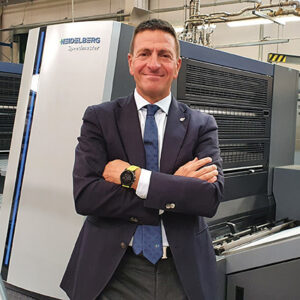
Face to face with Mauro Antonini, Sales & Marketing Manager, Vice President of the Board of Heidelberg Italia: Positive balance and a roaring drupa for Heidelberg
We asked Mauro Antonini, Sales & Marketing Manager, Vice President of the Board of Heidelberg Italia, to take stock of the past year: “in 2022 at a global level, even if the financial year will end at the end of March, we performed very well, even above expectations, with many satisfactions in various areas of the market; also in Italy we have achieved excellent results, almost better than at a global level in proportion, and also in this case with better results than those envisaged for us by our parent company, first of all because we have maximized all possible fiscal aid for the purchase, but also because we managed to make customers understand that large systems must work at full capacity, so it is useless to have many machines that work little, it is better to have fewer but more productive machines. Thanks to Heidelberg technology we have harmonized production areas at many printers, installing new machines to replace old models, even if they are perfectly functional, but the best achievement is that new customers have also arrived; we convinced them thanks also to the many demonstrations carried out at our demo center in Wiesloch, in short we convinced them with facts and not with abstract concepts, making them understand the real economic advantages of using a Heidelberg printing machine”.
The Lifecycle Smart to Lifecycle Plus model has also been received very positively in Italy: there are already five companies that are producing with this method which requires Heidelberg to offer certified consumables, technical assistance, remote connection and consultancy to make the most of the machine for printing, for the use of which the customer pays an amount based on the cost per sheet. “Practically the customer only has to think about printing, but obviously it is a proposal that we can make to structured companies, already very productive. Thanks to this option, some produce more copies than those contracted, and”, underlines Mauro, “this sort of subscription is an additional system that neither intends nor can replace the traditional purchasing method”.
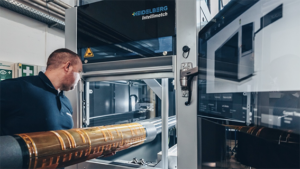 2024 will be the year of a highly anticipated drupa and Heidelberg is preparing for an important participation, with a large exhibition space with areas dedicated to all sectors of the market, because “we are convinced that there will be many interested customers who will be eager to see first-hand the machines, and drupa will reserve important innovations: engineering of new parts of the machines also in relation to AI, which will be increasingly widespread in the machine and it will be very interesting for entrepreneurs to evaluate this aspect carefully, because it is not just a question of buying a machine but a system that allows to resolve a phase of the production cycle”, says Mauro. Speaking of automation, it is impossible not to mention Plate to Unit, which already has an installation in Italy at a very productive customer (mainly active in the web-to-print sector). Plate to Unit is a robot that inserts plates automatically going from the CtP to the printing machine to rationalize the production flow: companies that have many job changes will necessarily have to automate the plate change.
2024 will be the year of a highly anticipated drupa and Heidelberg is preparing for an important participation, with a large exhibition space with areas dedicated to all sectors of the market, because “we are convinced that there will be many interested customers who will be eager to see first-hand the machines, and drupa will reserve important innovations: engineering of new parts of the machines also in relation to AI, which will be increasingly widespread in the machine and it will be very interesting for entrepreneurs to evaluate this aspect carefully, because it is not just a question of buying a machine but a system that allows to resolve a phase of the production cycle”, says Mauro. Speaking of automation, it is impossible not to mention Plate to Unit, which already has an installation in Italy at a very productive customer (mainly active in the web-to-print sector). Plate to Unit is a robot that inserts plates automatically going from the CtP to the printing machine to rationalize the production flow: companies that have many job changes will necessarily have to automate the plate change.
With intelligent algorithms and the use of AI, the set-up of the printing machine is completely automatic, but there is more because “essentially the machine learns from what is done: as the operator uses the machine, thanks to big data and job preparation orchestrated by the SW Prinect package, the machine itself processes all the information and therefore in the end manages to give the right advice to arrive at the result in the best way, so everything is optimized, and production becomes reliable and repeatable”, explains Mauro.
Speedmaster XL 106 with speed of up to 21000 sheets per hour is very interesting for customers in the cardboard converting sector; another sector in which Heidelberg is very strong is that of IML labels, for which it offers a dedicated package; in Italy there are various companies that are using it.
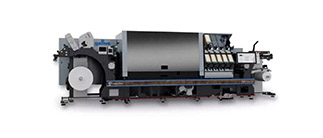 As regards post-printing, robotization will be increasingly integrated, which will carry out many of loading and unloading operations of the machines, a substantial help to operators and productivity. The label market, which is undergoing a technological transformation, has seen Heidelberg as protagonist with numerous installations of digital and hybrid machines, specifically Gallus Labelfire and Gallus one.
As regards post-printing, robotization will be increasingly integrated, which will carry out many of loading and unloading operations of the machines, a substantial help to operators and productivity. The label market, which is undergoing a technological transformation, has seen Heidelberg as protagonist with numerous installations of digital and hybrid machines, specifically Gallus Labelfire and Gallus one.
Mauro also reminds us of the importance of the agreement between Heidelberg Italia and Fujifilm Italia for the marketing in the Italian market of digital sheet-fed printing machines built by the Japanese manufacturer, thus increasing the portfolio of Versafire digital proposals with Fujifilm inkjet and toner technology: “this collaboration will certainly be developed and customers are appreciating it very much because our approach shows that we are a company that is moving towards the future, not only being focused on its own equipment but with the aim of integrating others”.
Last but not less important, the topic we discuss with Mauro is sustainability: “all the printing machines installed in the last three years are all carbon neutral, and this is important because our approach can also act as a driving force for other manufacturers, in our opinion it is necessary to set an example, and we have chosen to offer and install all sustainable machines, this is a very fundamental aspect for those who produce packaging”.






